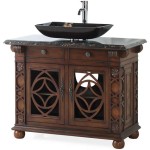How To Tell What Bathroom Sink Is Made Of
Understanding the material composition of your bathroom sink is crucial for various reasons. It influences durability, maintenance requirements, and aesthetic appeal. Different materials offer unique advantages and disadvantages, so making an informed decision is essential. This article delves into the essential aspects of identifying the material of a bathroom sink, providing a comprehensive guide to assist you in this process.
### Visual InspectionThe first step in determining the material of a bathroom sink is visual inspection. Observe the surface closely for any distinctive characteristics that may provide clues. Porcelain sinks typically have a smooth, glossy finish, while ceramic sinks tend to have a more textured surface. Stone sinks, such as marble or granite, often exhibit natural veining or patterns. Acrylic sinks, on the other hand, have a seamless and non-porous surface.
### Scratch TestA simple scratch test can further aid in material identification. Use a sharp object, such as a nail or a knife, to gently scratch the surface of the sink. Porcelain and ceramic sinks will not scratch easily, while acrylic sinks will likely show visible marks. Stone sinks may scratch depending on their hardness and durability.
### Acid TestFor a more conclusive test, apply a small drop of vinegar or lemon juice to an inconspicuous area of the sink. If the surface reacts with the acid, effervescent bubbles will appear. This indicates that the sink is made of marble or limestone, as these materials contain calcium carbonate, which reacts with acids.
### Sound TestTapping on the surface of the sink can also provide valuable information. Porcelain and ceramic sinks typically produce a high-pitched, resonant sound, while stone sinks sound more solid and dense. Acrylic sinks, due to their hollow construction, often produce a dull thud when tapped.
### Weight TestThe weight of the sink can also be a helpful indicator of its material. Porcelain and ceramic sinks are generally heavier than acrylic sinks, while stone sinks are the heaviest. This test is particularly useful for differentiating between solid surface and hollow core acrylic sinks.
### ConclusionIdentifying the material of your bathroom sink requires a combination of visual inspection, physical tests, and observation. By considering these essential aspects, you can determine the material composition of your sink with confidence. This knowledge will empower you to make informed decisions regarding maintenance, repairs, and aesthetic upgrades, ensuring the longevity and beauty of your bathroom.

How Can I Tell What My Bathroom Sink Is Made Of

What Is My Bathroom Sink Made Of Mr Kitchen Faucets

What Is My Sink Made Of

Sink Types Material Kitchen Bathroom Imagine Stoneworks

Understanding Types Of Bathroom Sinks Sanctuary Bathrooms

What Are Bathroom Sinks Made Of

What Is My Bathroom Sink Made Of Mr Kitchen Faucets

Henry Dreyfuss Designed Crane Sinks How To Tell If Yours Was Made Before Or After World War Ii Retro Renovation
Bathroom Sink Material Guide Signature Hardware

Trend Alert Integrated Bathroom Sink Studio Shk Interior Design Firm
Related Posts







